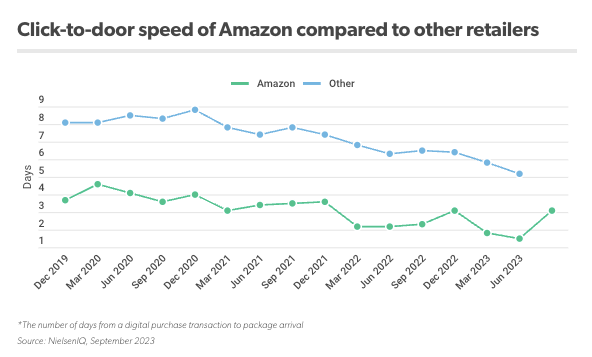Research Briefing: Amazon faces increased delivery competition

In this edition of the weekly briefing, we examine how retailers are tackling fulfillment and delivery as seen in data from Modern Retail+ Research.
Interested in sharing your perspectives on the future of retail, technology and marketing?
Apply to join the Modern Retail research panel.
Retailers ramp up fulfillment capabilities to compete with Amazon
Breaking News: Walmart had its earnings call recently and announced stronger performance in order fulfillment. The company disclosed that 20% of its orders were delivered in under three hours and that the cost per delivery was reduced by almost 40%. With its improvements in fulfillment, Walmart continues to be a main competitor to Amazon. One area that Walmart has utilized is its retail locations. By using physical stores to aid in fulfillment, Walmart has been able to speed up delivery. This tactic is also used by other retailers, like Target; however, Amazon is not able to tap into the same strategy due to its lack of physical stores. Amazon previously had set precedences in delivery speed with its Prime program, but as competitors continue to ramp up their own fulfillment speed and services, Amazon may see more competitors chip away at its market share.
Questions: How are other competitor’s fulfillment speed compare to Amazon’s? What are retailers striving towards in the future?
Answers From Research:

Walmart and Target have largely undertaken a race to build up their fulfillment and delivery infrastructures in order to keep up with online giant Amazon’s expansive same-day delivery network and membership programs. Part of their plans to cut down on last-mile delivery costs have included building more micro-fulfillment centers and large-format stores that act as fulfillment hubs for online orders, including drive-up and same-day local deliveries.
To help with local deliveries, Target Corp. invested $100 million to build a larger network of supply chain hubs, dubbed “sortation centers,” near Target stores in order to sort, batch and route orders that store staffers pack. With more sortation centers close to stores, Target can deliver more packages the next day. By January 2026, Target plans to have built 15 of these facilities. Target executives believe the store-based fulfillment model boosts inventory and supply chain capacity, and the retailer can fulfill demand across any of its omnichannel offerings, whether that’s drive-up, in-store sales or online orders.
In the drugstore space, Walgreens and CVS have automated fulfillment by building more AI-backed fulfillment centers to support their pharmacy businesses. Walgreens began using AI to accurately forecast demand and to optimize its network of fulfillment centers. It also implemented centralized services to control inventory and reduce workload. In 2021, Walgreens announced plans to open 11 fully automated micro-fulfillment centers by 2022. So far, nine of the automated centers have opened, but the company is now taking a step back to re-evaluate the benefits of its strategy.
Want to learn more: The Modern Retail+ Fulfillment Index examines how retailers are improving fulfillment services.
READ MORE ABOUT RETAILER FULFILLMENT
See research from all Digiday Media Brands:

